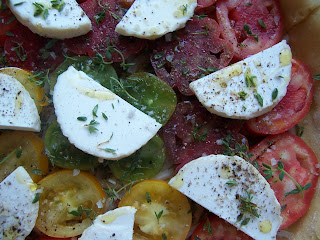Getting asked by the collaboration to go to these conferences may sound like a big deal, but, in reality it is quite normal. In our field collaborations rather than people are asked to give talks, and we use our favorite tool, committees, to divy up the engagements. Talks are assigned to young people on the job market or to senior people as a reward for their service to the collaboration. There is a priority list which makes sure that the talks are evenly divided so that no one gets overlooked. Its a quirk of our system that often the presenter gives talks on analyses he or she has not worked on. Its a legitimate method because each of us are authors on all of the analyses so we should be able to talk about any of them, but in reality the speaker has to do quite a bit of homework to put together the talk. Half of my talk at the MIT concerned an analysis I didn't work on; it was useful to learn about it so that I could present the material in a coherent way.
Two days before I left Geneva I made a tomato tarte that was as good as it was simple. It comes from David Leibovitz's blog, with very minor modifications. David's recipes are always excellent, and this one is no exception. I used an assortment of heirloom tomatoes of different colors which had a very pretty effect. Its a very buttery crust, so you might want to try something a bit healthier, like this one.
Heirloom Tomato Tarte
4 or 5 medium sized heirloom tomatoes, sliced 1/2 inch thick
1/2 a small onion sliced as thinly as possible
A few tablespoons of dijon mustard (I used the unground à l'ancienne style)
plenty of fresh thyme, leaves only
salt and pepper
olive oil
8 oz goat cheese; it's best to use one with a rind of some sort. mine was very slightly aged so had a thin rind.
tart dough:
1 1/2 cups flour
4 1/2 ounces unsalted butter, chilled, cut into cubes
1/2 teaspoon salt
1 large egg
2-3 tablespoons cold water
4 1/2 ounces unsalted butter, chilled, cut into cubes
1/2 teaspoon salt
1 large egg
2-3 tablespoons cold water
First make the tart dough. Mix the flour and salt in a bowl. In a food processor, stand mixer or using your hands, mix or pulse the butter into the flour until the mixture has a crumbly texture and there are no large pieces of butter left.
Mix the egg and 2 tablespoons of water in a bowl. Add to the food processer and pulse until the liquid is incorporated and the dough holds together. Add the extra water if needed.
On a floured surface, roll the dough into a ball. Roll until it is about 1/4 -1/2 in thick. You can get it into the tart pan with an ingenious (and probably standard) method that David outlines: you flour the rolling pin and roll the dough up around the pin to transfer it to the pan.
Press the dough into the pan and dock it with a fork. Preheat the oven to 425F.
Smear the bottom of the crust with the mustard. You can put a nice thick layer on if you like mustard. Then spread the onion on top, followed by half of the thyme.
Arrange the tomatoes on top in concentric circles. Mine didn't overlap, but they probably could without too much trouble. Arrange the cheese on top and sprinkle with the rest of the thyme. Add salt and pepper to taste and then drizzle with olive oil.
Bake for 30 minutes or so. Be careful to check that it doesn't burn--as you can see from the picture below, mine was a bit charred. Serve hot or warm. I had leftovers on the plane and they were nearly as good as when it was fresh!







